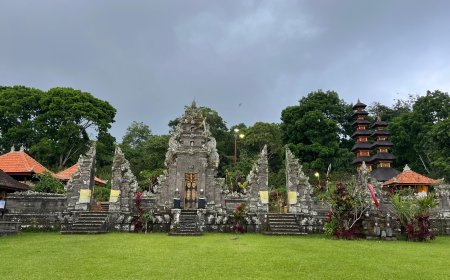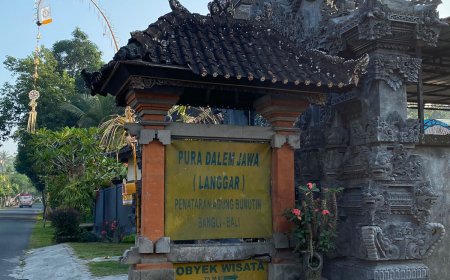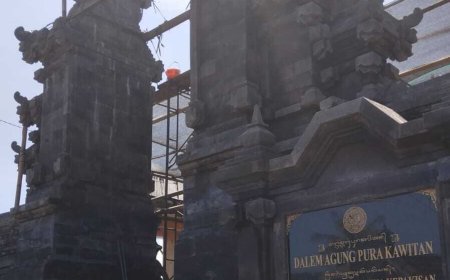Dalem Benculuk Tegeh Kuri Temple: A Historical Heritage of the Gelgel Kingdom Klungkung
Kawitan temple is a type of Balinese temple that is specific to a particular family lineage, where religious activities and worship are performed exclusively by family members. These traditions are passed down through generations. One such kawitan temple dedicated to ancestral worship is Dalem Benculuk Tegeh Kuri Temple. This temple holds a fascinating history related to the Arya Dalem Benculuk (Arya Tegeh Kuri) family and the Gelgel Klungkung Kingdom.
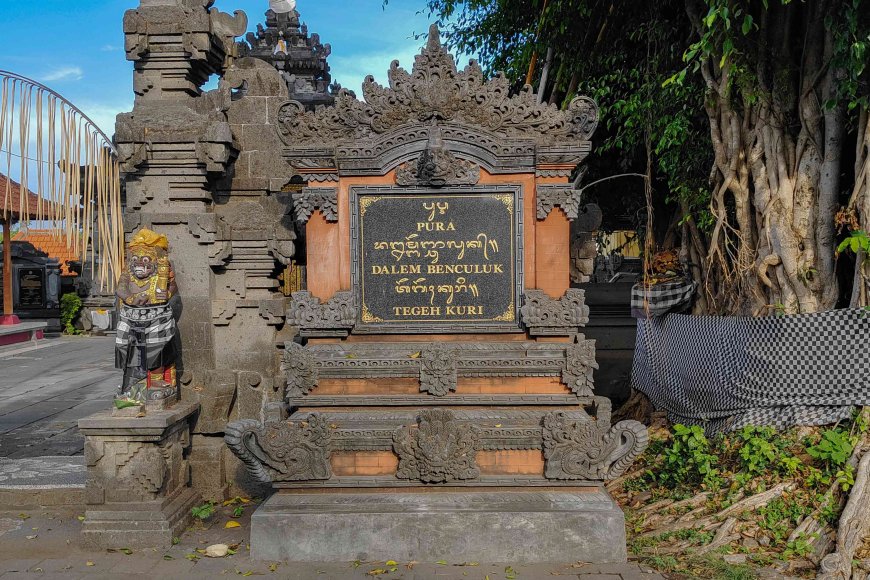
Dalem Benculuk Tegeh Kuri Temple has a deep historical connection to Arya Dalem Benculuk (Arya Tegeh Kuri), a descendant of King Dalem Shri Aji Kresna Kepakisan of the Gelgel Klungkung Kingdom. Arya Dalem Benculuk is a notable figure in Balinese history, known for his contributions in maintaining stability and prosperity in the Gelgel Klungkung region. From the 14th to the 17th century, the Gelgel Kingdom reached its peak under the rule of King Dalem Waturenggong. Arya Dalem Benculuk, as a member of the royal lineage, played an essential role in preserving the traditions and customs of the kingdom. Additionally, he contributed to political and military strategies that upheld the kingdom’s success. The temple was established in his honor, serving as a place to maintain a spiritual connection with ancestors and uphold the cultural heritage he carried.
The Gelgel Klungkung Kingdom was one of the most influential realms in Bali at the time, controlling much of the island and establishing diplomatic relations with other kingdoms in the archipelago. King Dalem Shri Aji Kresna Kepakisan, the founder of the Gelgel dynasty, brought significant changes to Bali's social and religious structures, integrating Hindu values with local culture. The founding of Dalem Benculuk Tegeh Kuri Temple reflects the importance of maintaining a spiritual relationship with ancestors and Hindu deities, reinforcing the role of spirituality and culture at the center of Balinese life. The temple hosts various important religious ceremonies, which not only reinforce the community's religious identity but also preserve the customs and traditions passed down for centuries.
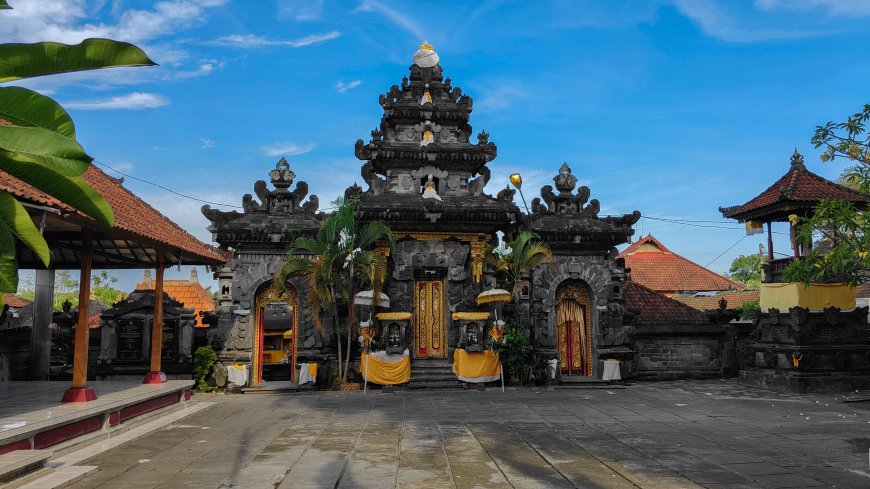
Madya Mandala Area of Dalem Benculuk Tegeh Kuri Temple (Photo Source: Personal Collection)
The architecture of Dalem Benculuk Tegeh Kuri Temple is rich in philosophical meaning. The Candi Bentar, or main gate, is adorned with intricate stone carvings depicting epic stories from Hindu mythology. This gate symbolizes the boundary between the outside world and the sacred temple grounds, creating a sacred atmosphere for all who enter. It also reflects the concept of Tri Hita Karana, emphasizing balance between humanity, nature, and the divine.
Inside the temple, there are several main structures, such as Pelinggih Ratu Nyoman Sakti, Bale Agung, and Gedong Penyimpenan. Each building is intricately designed with symbolic meanings, embodying the philosophy of Panca Maha Bhuta, the five elements of nature: earth, water, fire, air, and ether. The use of natural materials such as sandstone, thatch, and teakwood lends a traditional and beautiful aesthetic, showing reverence for nature.
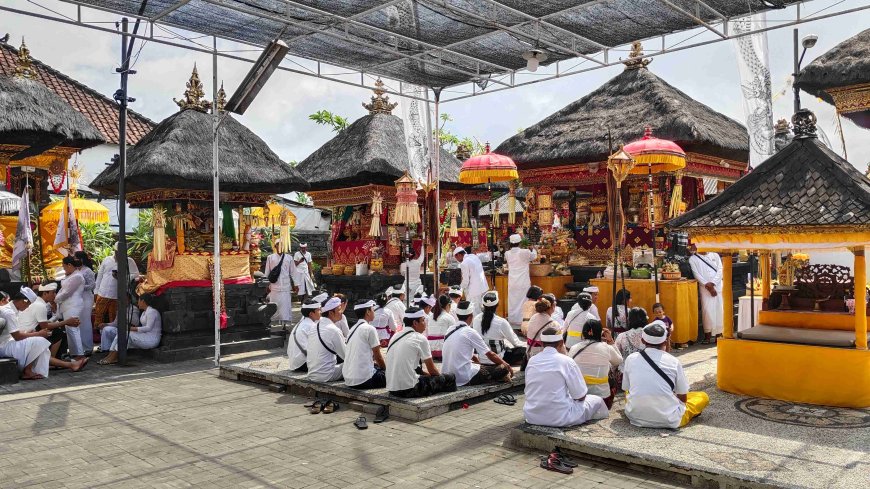
Utama Mandala Area of Dalem Benculuk Tegeh Kuri Temple (Photo Source: Personal Collection)
The Piodalan ceremony at Dalem Benculuk Tegeh Kuri Temple takes place every 210 days on Wuku Wayang. Preparations for Piodalan begin days before with ngerajah, a ritual to cleanse the temple and its surroundings of physical and spiritual impurities. One of the essential preparations is Mekarya Banten, the crafting of various offerings to be used in the ceremony. On the day of Piodalan, the ceremony begins with nunas tirta, the collection of holy water from a sacred spring or revered water source. This holy water is then used to purify the temple grounds and all ceremonial items. Following this, mendet is performed, a ritual to invite ancestral spirits and deities to attend and bless the ceremony. The community gathers in front of the main shrine to present offerings accompanied by traditional gamelan music.
The ceremony continues with the Mendet Barong, a Barong dance representing the spirit protector to ward off evil spirits and maintain the temple’s sanctity. The Rejang dance, performed by village women, honors the gods during the ritual. The peak of the Piodalan ceremony is the melaspas ritual, a purification and consecration ceremony for all temple structures and areas to ensure they remain sacred and protected from negative influences. Following all the rituals, the community holds a megedong-gedongan, a communal meal that symbolizes unity and mutual support.
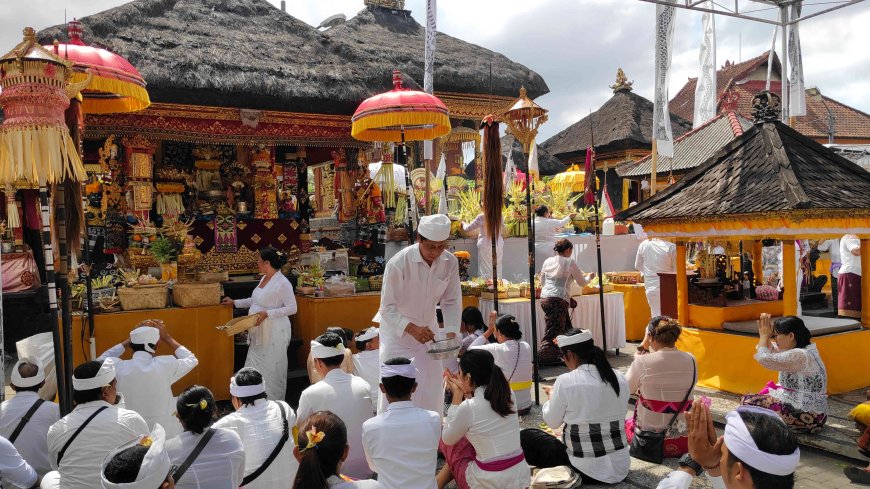
Piodalan Ceremony at Dalem Benculuk Tegeh Kuri Temple (Photo Source: Personal Collection)
Dalem Benculuk Tegeh Kuri Temple is a kawitan temple in Bali with profound historical and spiritual significance. Dedicated to the ancestral worship of the Arya Dalem Benculuk (Arya Tegeh Kuri) family, descendants of King Dalem Shri Aji Kresna Kepakisan of the Gelgel Klungkung Kingdom, this temple serves not only as a place of worship but also as a guardian of Balinese traditions and customs. Through ceremonies such as Piodalan, it strengthens the Balinese community’s religious identity and preserves a cultural heritage dating back centuries. The temple's architecture, imbued with philosophical meaning, underscores the importance of balance between humanity, nature, and the divine. An integral part of local life, this temple reminds us always to honor and respect our ancestors by preserving a deep, spiritual beauty.

















































